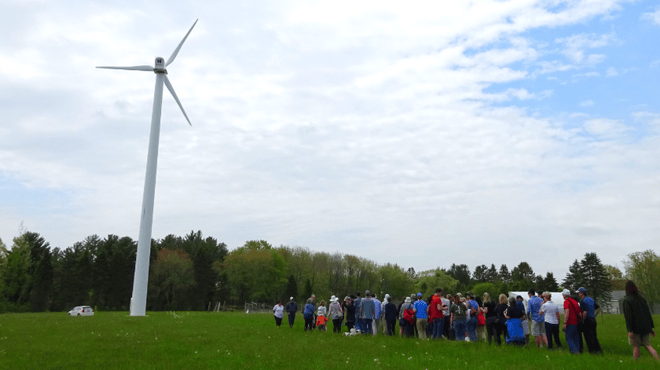 On November 15, the Mass. Department of Energy Resources published a revised Municipal Aggregation Manual & Best Practices Guide and asked for public comments by December 7. For information, visit here.
On November 15, the Mass. Department of Energy Resources published a revised Municipal Aggregation Manual & Best Practices Guide and asked for public comments by December 7. For information, visit here.
The following are our comments.
Our Comments
First, the Manual references the Attorney General’s work on comparing rates paid by customers of competitive power suppliers to Basic Service (p5). That is helpful but the reference was far too understated. The reports by the AG on that subject provide unambiguous evidence that the competitive power supply market (outside the aggregation model) should be abolished. At the least, the manual could have included some excerpts from the AG reports. Any municipal official or citizen thinking about starting the process of municipal aggregation ought to know well the facts revealed by the AG reports.
Second, the Manual does a disservice to the public in the section comparing municipal aggregation rates versus Basic Service rates (p12). It is certainly appropriate to make the disclaimer that municipal aggregations cannot guarantee that their rates will always be lower than Basic Service. However, there is very easily obtainable empirical evidence showing that many municipal aggregations have performed better than Basic Service in recent years, even before the recent spikes in Basic Service rates. Green Energy Consumers produced a report showing these comparisons in our report, “Green Power at Lower Cost.”

By our analysis of rates before the recent Basic Service price spikes, if every residential customer of investor-owned utilities were served by municipal aggregation, the total savings would have amounted to over $200 million per year compared to Basic Service, while also adding about 1.6 million megawatt hours per year of Class I renewable energy to the grid above the state’s requirements. This does not include savings that would accrue to small commercial customers.
While we might not expect DOER to cut and paste entirely from our report, we would expect DOER and DPU to produce their own analyses and make them public so that municipal officials and citizens can have the information. As biased as we might be at Green Energy Consumers Alliance, we believe that DOER and DPU’s failure to recognize the superiority of aggregation over Basic Service has been extremely harmful to consumers and to the Commonwealth’s greenhouse gas reduction goals. Quite frankly, we do not understand why the Commonwealth has turned a blind eye.
Third, the Manual does a good job of explaining why aggregations working to include more renewable energy than required by state law should focus on Class I RECs. However, the Manual could add a paragraph that explains how many aggregations offering a green default product also allow consumers to easily “opt-down” to a product that does not add more Class I RECs than required by the RPS and is, therefore, less expensive.

Last but not least, the Manual explains the process that a municipality must follow to develop and operate an aggregation. But it fails to point out that the most difficult part of the aggregation process is dealing with the Department of Public Utilities. The DPU takes far too long to approve aggregation plans, as reported by the Boston Globe in October, “How the DPU is preventing communities from lowering utility bills — and carbon emissions.” The City of Quincy, of which I am a citizen, has been waiting for almost two years for approval. Because the approval did not occur in advance of the National Grid Basic Service price spike, the DPU is costing me hundreds of dollars.
Our Comments on the Massachusetts Municipal Aggregation Manual & Best Practices Guide
The following are our comments.
Our Comments
First, the Manual references the Attorney General’s work on comparing rates paid by customers of competitive power suppliers to Basic Service (p5). That is helpful but the reference was far too understated. The reports by the AG on that subject provide unambiguous evidence that the competitive power supply market (outside the aggregation model) should be abolished. At the least, the manual could have included some excerpts from the AG reports. Any municipal official or citizen thinking about starting the process of municipal aggregation ought to know well the facts revealed by the AG reports.
Second, the Manual does a disservice to the public in the section comparing municipal aggregation rates versus Basic Service rates (p12). It is certainly appropriate to make the disclaimer that municipal aggregations cannot guarantee that their rates will always be lower than Basic Service. However, there is very easily obtainable empirical evidence showing that many municipal aggregations have performed better than Basic Service in recent years, even before the recent spikes in Basic Service rates. Green Energy Consumers produced a report showing these comparisons in our report, “Green Power at Lower Cost.”
By our analysis of rates before the recent Basic Service price spikes, if every residential customer of investor-owned utilities were served by municipal aggregation, the total savings would have amounted to over $200 million per year compared to Basic Service, while also adding about 1.6 million megawatt hours per year of Class I renewable energy to the grid above the state’s requirements. This does not include savings that would accrue to small commercial customers.
While we might not expect DOER to cut and paste entirely from our report, we would expect DOER and DPU to produce their own analyses and make them public so that municipal officials and citizens can have the information. As biased as we might be at Green Energy Consumers Alliance, we believe that DOER and DPU’s failure to recognize the superiority of aggregation over Basic Service has been extremely harmful to consumers and to the Commonwealth’s greenhouse gas reduction goals. Quite frankly, we do not understand why the Commonwealth has turned a blind eye.
Third, the Manual does a good job of explaining why aggregations working to include more renewable energy than required by state law should focus on Class I RECs. However, the Manual could add a paragraph that explains how many aggregations offering a green default product also allow consumers to easily “opt-down” to a product that does not add more Class I RECs than required by the RPS and is, therefore, less expensive.
Last but not least, the Manual explains the process that a municipality must follow to develop and operate an aggregation. But it fails to point out that the most difficult part of the aggregation process is dealing with the Department of Public Utilities. The DPU takes far too long to approve aggregation plans, as reported by the Boston Globe in October, “How the DPU is preventing communities from lowering utility bills — and carbon emissions.” The City of Quincy, of which I am a citizen, has been waiting for almost two years for approval. Because the approval did not occur in advance of the National Grid Basic Service price spike, the DPU is costing me hundreds of dollars.
Tags:
Comments
Related Posts
Massachusetts Electric Car Charging Council Issues Report
Last month, we published a blog encouraging residents of Massachusetts to send in comments to the Electric Vehicle...
Massachusetts Residents: Take Action For Smart Charging Rates for Electric Cars
If you drive an electric car, it matters when you plug in and charge – both in terms of the emissions caused by...